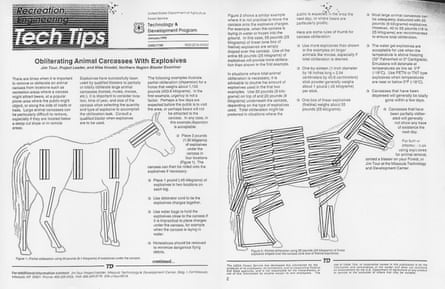Shoshone national forest officials pause gruesome policy of exploding carcasses to minimize hazard during dry spell
Richard LuscombeWed 16 Oct 2024 17.57 BSTLast modified on Wed 16 Oct 2024 20.52 BSTShareRangers in Wyoming’s Shoshone national forest believe they have figured out how to mitigate an elevated risk of wildfires: they are no longer using explosives to blow up dead horses.
The temporary pause in the seemingly bizarre and somewhat gruesome policy comes as a lengthy dry spell in the state’s backcountry combines with hotter-than-usual temperatures, increasing the possibility of wildfires. Experts say drought and heat from the climate crisis is fueling a rise in extreme wildfires worldwide.
In less extreme times, the US Forest Service routinely blows up carcasses of fallen horses – after removing horseshoes to minimize the hazard from flying metal debris – to prevent gatherings of ravenous grizzly bears that frequent Wyoming’s open spaces.
The service follows directions from its own manual, Obliterating Animal Carcasses With Explosives, detailing best practices for detonating horses, moose and mules.
Created by the forest service’s Missoula technology and development center in 1995, it offers advice including where to place the charges and how many to use.
“Carcasses that have been partially obliterated will generally not show any trace of existence the next day,” the manual says.
 View image in fullscreenA 1995 manual from the US Forest Service detailing how to blow up animal carcasses. Photograph: US Forest ServiceThe episode was first reported by the Cowboy State Daily.
View image in fullscreenA 1995 manual from the US Forest Service detailing how to blow up animal carcasses. Photograph: US Forest ServiceThe episode was first reported by the Cowboy State Daily.
Evan Guzik, Shoshone’s public affairs officer, said the service had not adopted a wholesale suspension of the use of explosives, but a temporary pause was considered necessary in the case of two horses that slipped and fell to their deaths last weekend on a remote trail near the town of Cody.
Rangers decided not to blow up the horses, and opted instead to maneuver them to the foot of a steep slope and reroute the trail around them, he said.
“Each incident is approached as a unique event and assessed individually. In this particular case, the area was thick with timber and brush that was too dry to safely obliterate the carcasses,” Guzik told the Guardian.
“[The] folks on the ground made a risk-based decision and felt that they could minimize the hazard of a carcass near a trail by creating the reroute and canvassing the area with signs alerting trail users of the potential for grizzlies in the area … without increasing the chance to spark a new wildfire.
“That may not be the case for other similar situations,” he said.
skip past newsletter promotionSign up to Down to Earth
Free weekly newsletterThe planet’s most important stories. Get all the week’s environment news – the good, the bad and the essential
Privacy Notice: Newsletters may contain info about charities, online ads, and content funded by outside parties. For more information see our Privacy Policy. We use Google reCaptcha to protect our website and the Google Privacy Policy and Terms of Service apply.after newsletter promotion
Cody, a popular tourist town in north-east Wyoming named for its co-founder, the wild west showman Buffalo Bill Cody, has a notably dry climate and near-constant winds, making the area particularly susceptible to wildfires.
Northern Wyoming, southern Montana and other western states were affected by large numbers of wildfires this summer, and many areas are still vulnerable to new blazes during the mostly dry conditions of fall.
Texas wildfire puts spotlight on cattle ranchers and climate extremes: ‘so badly burned they can’t be saved’Read moreWyoming, meanwhile, has an abundant population of grizzly bears, and while encounters with humans are uncommon, they can be dangerous. In May, a man was attacked and seriously injured by a grizzly in Grand Teton national park, and in July last year a woman was fatally mauled on a trail west of Yellowstone national park in Montana.
Bear gatherings are more of a concern at this time of year, experts say, because most are in their hyperphagia stage, otherwise known as when they fatten up for winter hibernation. The recently concluded Fat Bear Week at Katmai national park in Alaska celebrates the process while educating the public about the animals.
Guzik said changing seasons meant a decreasing likelihood of rangers having to decide whether to use explosives on carcasses to keep hungry grizzlies away. As well as the bears heading for hibernation, wetter conditions are expected soon. “All our fingers are crossed for rain or snow,” he said.
